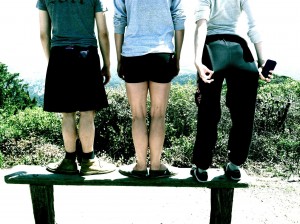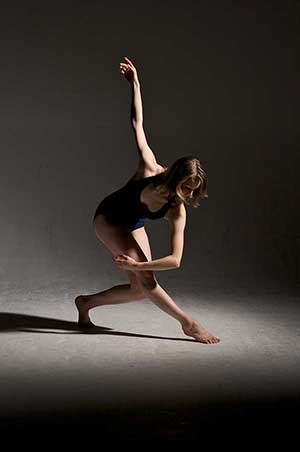What Gives Ballet its Staying Power
By Andrea Thompson
Classical ballet stands its ground in the evolution of dance in the same way that classical literature, painting, and music maintain relevancy in their respective fields. Artists in each discipline have been busily innovating and inventing, creating entirely new approaches that actively rebel against classicism, and yet classicism remains. It has not been snuffed out nor forgotten, neither in its appeal nor its practice. Classical ballet, for instance, proffers a basis for training that dancers of multiple genres can relate or at least refer to. It provides a structure and vocabulary that is “tried and true” in its own right, but also a starting point for other types of dance. Forms and movements that are practiced today are the same ones that were practiced hundreds of years ago, and although physical possibilities for the forms are increasing and evolving as time goes on, the original qualities that made ballet captivating at its inception are the same qualities that delight audiences to this day. Ideals of ethereal beauty, lightness, magic, elegance, grace, power, and physical capability are thrilling when displayed in the flesh. When dancers actually approach these ideals – when they come as close as a human can get to some vision of perfection – something happens to the audience. Bearing witness to something unbelievable, implausible, and impossibly beautiful is a memorable, moving experience. Performances of classical ballet can offer that kind of experience to their audiences, and that’s what gives the art form staying power.
I will, as a contemporary dancer, continue to practice ballet every day for the foreseeable future. Not because I plan on donning pointe shoes and sharing my Odette/Odile interpretation with the world, but because as a physical practice, ballet is an essential component of the work that I do on myself. It is as indispensable to my personal research as the improvisation, contemporary choreography, and movement investigation I engage in. I started my ballet training as a young girl, and it employs a vocabulary I’ve become extremely familiar with. I enjoy the challenge of encountering this lexicon in innumerable new and surprising arrangements today, although I did go through a period where ballet seemed very boring. I decided to branch out into modern dance, but quickly realized “modern” was a relative term and found that what I was most interested in seemed to group itself under the “contemporary” umbrella. Time spent at the San Francisco Conservatory of Dance introduced me to the worlds of Forsythe, gaga, improvisation, thoughtful contemporary movement to dubstep, and a wealth of comrades I would later dance with and for, professionally.
As a movement language ballet is my mother tongue, so when I first delved into those realms where movements don’t have names I had to “translate” everything back to ballet in my head to keep a handle on what was happening. As an initial departure into other languages this method of translation worked for a little while, but ultimately it was not an effective way to teach a young dog new tricks. When guided to taking a different approach, I let go of ideas about movement that I took for granted in a ballet context in order to gain an understanding of something else, something new and unclear but definitely valuable. The thought of unclenching, unpointing, disengaging, becoming small, looking silly, being silly – these were concepts I hadn’t applied to dance before. Then again, dance had been synonymous with ballet before. To take in new ideas, I had to open myself up to the possibility that not everything was based upon or related back to ballet. Could it be? Ballet might not be relevant to everything?
Having taken this approach to contemporary movement training for a few years now, I can say that I am both a more sophisticated ballet dancer (ballet class-taker?) as well as significantly more versed in other genres of dance. I’ve found that exactly like spoken languages, some ideas and vocabulary in dance don’t have direct translations from one language to another. However, I’ve also learned that applying them across vernaculars anyway can make for beautiful discoveries, metaphor and poetry, and it can shine a new light upon established notions. Becoming okay with feeling silly allowed me to push beyond what I thought I was capable of in a ballet context, whereas the education that ballet has given my calves continues to inform my contemporary movement. I’ve discovered ways that contemporary dance is like and unlike ballet, and my known ballet vocabulary has therefore become subject to new approaches. Ballet is relevant, alright. It just keeps getting makeovers. I now have a number of new lenses through which I can look at ballet, just as I used to view all other dance through the ballet lens. I have fallen in love with classical ballet all over again because I’ve found that its vocabulary is not as limited and boring as I had once presumed. Ballet possesses all the original qualities I admired about it as a little girl – the grace, lightness, and elegance – and thanks to my updated dealings with it, I’ve found it to be simultaneously gritty, vibrant, physical, malleable, and most importantly limitless as well.
It is my strongly held belief that ballet will never die. Ballet can be extremely interesting, it’s wonderful training, and ballet and contemporary work complement, support and overlap each other. Ballet is the OG – even though it’s a living fossil of centuries-old dance, the extent to which it is still practiced and performed today proves its relevancy. There’s an audience-based demand for its classicism. Other genres are not trying to out-do or obliterate it – they need it for contrast, so that dance doesn’t homogenize. All dance helps give context and contrast to all other dance, and ballet has the unique characteristic of being a piece of dance history, dance present and dance future. It’s no passing fad, it’s “classical” because it is a classic: timeless. It is a constant puzzle left for us by those who invented it, which generations after generations will try to figure out- but no one ever fully will. Those who are fluent enough to wield it as the powerful artistic tool that it is will be heralded as heroes and legends, and as long as the challenge of taking on ballet exists, people will step up to accept it. May audiences continue to realize how difficult, admirable, and impressive it is for dancers to do those effortless-looking things. And may they brave the ticket prices, go to a show, and allow themselves to be moved by what they see.
~~
Andrea Thompson currently dances for Hubbard Street 2 in Chicago, where she resides in a cozy igloo waiting for the polar vortexes to pass. Previously she’s danced for LoudHoundMovement and Zhukov Dance Theatre, and her training came primarily from the San Francisco Conservatory of Dance, the Ailey School, and the JKO School at ABT.
Second photo by Jaqi Medlock


